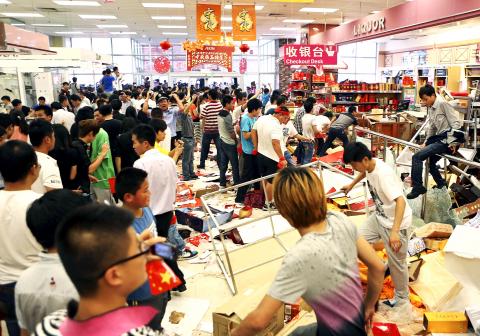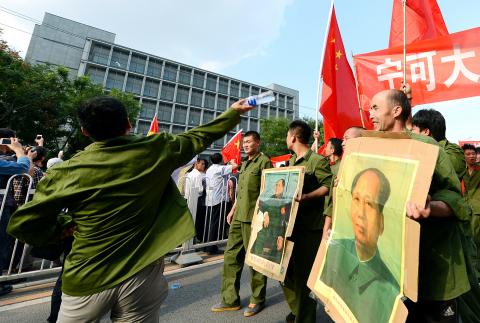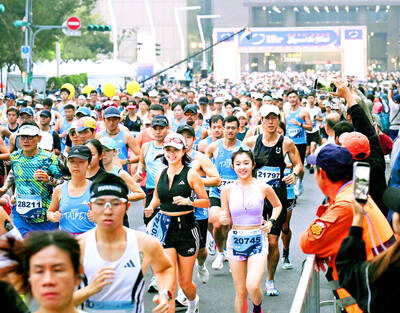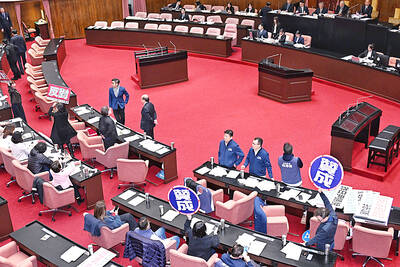Angry demonstrators attempted to storm the Japanese embassy in Beijing yesterday, state media said, as tens of thousands of people across China protested against Japan over a growing territorial dispute.
Riot police armed with batons and shields struggled to contain the swelling crowd outside the embassy, where witnesses said at least 2,000 people had gathered, some of them throwing stones and plastic bottles at the building.
A mob attempted to break into the embassy compound, but were stopped by armed police, Xinhua news agency said. It estimated the crowd at several thousand at its peak.

Photo: Reuters
Meanwhile, there were online reports that protests were staged in at least a dozen cities across China, with Japanese-built cars and Japanese restaurants being attacked by angry crowds.
Japanese media estimated 40,000 people took part in the protests nationwide.
On China’s Sina Weibo (新浪微博), a microblog similar to Twitter, images were posted of protests in Chongqing and Kunming.

Photo: AFP
Rallies were reported in several other places, including Nanjing, Xian and Taiyuan.
Much of the information about the protests posted online appeared to have been removed by the afternoon by China’s army of Internet censors — suggesting that Beijing is aiming to stop the row from spiraling further out of control.
The protests also did not feature on regular news bulletins on the state-run China Central Television.
The rumbling territorial dispute reached a new level this week, when Japan announced that it had bought islands in the East China Sea that it administers and calls the Senkaku Islands. The islands are also claimed by Taiwan, where they are called the Diaoyutai Islands (釣魚台), and China, where they are called the Diaoyu Islands.
Six Chinese ships sailed into waters around the archipelago on Friday, with Beijing saying they were there for “law enforcement,” leading Tokyo to summon the Chinese ambassador to protest what it insisted was a territorial incursion.
In the Chinese capital, where there have been large anti-Japan demonstrations for the past few days, roads were cordoned off and a helicopter hovered overhead, monitoring the embassy protest.
Nearby Japanese restaurants, which were all closed, appeared not to have been targeted by the angry crowds, but some protesters had draped Chinese flags over them.
Police monitored other demonstrations across China.
In Shanghai, police threw a security ring around the Japanese consulate, but allowed groups of protesters to approach the compound for short periods.
Scores waved Chinese flags, chanted slogans such as “Little Japanese” and held up signs insisting the islands were Chinese.
Police confiscated their signs and banners at the conclusion of the protest.
China and Japan are Asia’s two biggest economies with close trade and business ties. However, the relationship is often tense due to the territorial dispute and Chinese resentment over historical issues.
A Japanese diplomat said on Friday that Tokyo had issued a safety warning to its citizens in China after six “serious” cases of assault and harassment, all in Shanghai.

A car bomb killed a senior Russian general in southern Moscow yesterday morning, the latest high-profile army figure to be blown up in a blast that came just hours after Russian and Ukrainian delegates held separate talks in Miami on a plan to end the war. Kyiv has not commented on the incident, but Russian investigators said they were probing whether the blast was “linked” to “Ukrainian special forces.” The attack was similar to other assassinations of generals and pro-war figures that have either been claimed, or are widely believed to have been orchestrated, by Ukraine. Russian Lieutenant General Fanil Sarvarov, 56, head

SAFETY FIRST: Double the number of police were deployed at the Taipei Marathon, while other cities released plans to bolster public event safety Authorities across Taiwan have stepped up security measures ahead of Christmas and New Year events, following a knife and smoke bomb attack in Taipei on Friday that left four people dead and 11 injured. In a bid to prevent potential copycat incidents, police deployments have been expanded for large gatherings, transport hubs, and other crowded public spaces, according to official statements from police and city authorities. Taipei Mayor Chiang Wan-an (蔣萬安) said the city has “comprehensively raised security readiness” in crowded areas, increased police deployments with armed officers, and intensified patrols during weekends and nighttime hours. For large-scale events, security checkpoints and explosives

‘POLITICAL GAME’: DPP lawmakers said the motion would not meet the legislative threshold needed, and accused the KMT and the TPP of trivializing the Constitution The Legislative Yuan yesterday approved a motion to initiate impeachment proceedings against President William Lai (賴清德), saying he had undermined Taiwan’s constitutional order and democracy. The motion was approved 61-50 by lawmakers from the main opposition Chinese Nationalist Party (KMT) and the smaller Taiwan People’s Party (TPP), who together hold a legislative majority. Under the motion, a roll call vote for impeachment would be held on May 19 next year, after various hearings are held and Lai is given the chance to defend himself. The move came after Lai on Monday last week did not promulgate an amendment passed by the legislature that

PENTAGON ASSESSMENT: A US report said that even as China and Russia deepen their partnership, cooperation is hindered by a ‘mutual distrust’ of each other The Chinese People’s Liberation Army (PLA) as of October had doubled the number of ships and airplanes deployed around Taiwan compared with the previous two years, Vice Minister of National Defense Hsu Szu-chien (徐斯儉) said yesterday, a day after the opposition-controlled legislature voted against reviewing the government’s general budget for next year, including a NT$1.25 trillion (US$39.71 billion) special defense spending bill. The legislature’s vote against the Ministry of National Defense’s spending plans was regrettable, as the budget was designed to respond to the developing Chinese military threat, Hsu said on the sidelines of a legislative meeting on the general budget. Defense